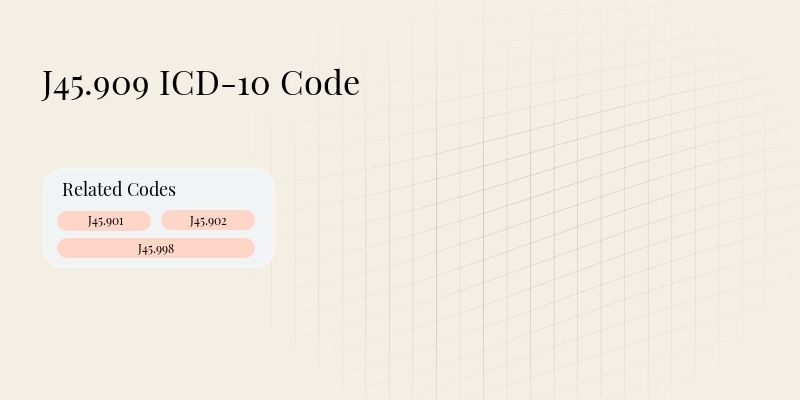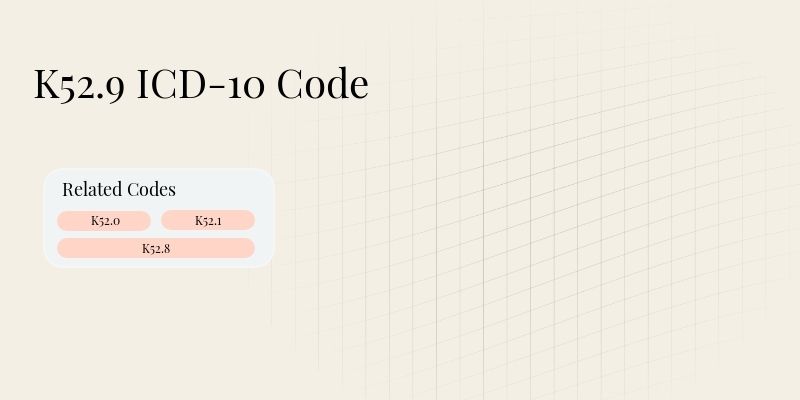
J45.909 ICD-10 Code: Reactive Airway Disease

Key Takeaways
- What J45.909 ICD-10 Code Covers: This code is used to document cases of reactive airway disease, which is commonly associated with asthma-like symptoms in patients. It allows healthcare providers to effectively communicate the patient's condition for treatment and billing purposes.
- Session duration requirements: Each session for treatment or consultation using this code may need to be documented, typically ranging from 15 to 60 minutes, depending on the complexity of the condition and the services provided.
- Who can use the code: This code can be employed by various healthcare providers including primary care physicians, pulmonologists, and emergency room staff who are diagnosing or treating patients with respiratory issues.
- Best practice for proper use: Ensure that the diagnosis is supported by clinical documentation, including patient history and treatment plans, to prevent claim denials and ensure accurate reimbursement.
- Example of actual usage: A patient presents with wheezing and shortness of breath after exposure to smoke; the physician assesses and documents these symptoms, using J45.909 for billing after providing a treatment plan.
What is J45.909 ICD-10 Code
The J45.909 code in the ICD‑10 classification system refers to reactive airway disease, which describes a condition where patients exhibit asthma‑like symptoms without a definitive asthma diagnosis. This designation is often used when symptoms arise due to environmental factors or other triggers, but the patient may not have a chronic asthma diagnosis.
Medical coders and healthcare providers must understand that this code allows for the documentation of transient respiratory symptoms, helping to ensure that patients receive appropriate treatment and that healthcare providers are reimbursed for their services. Clear and precise coding is essential for effective patient management and financial operations within healthcare settings.
Services Covered Under J45.909 ICD-10 Code
This code covers a variety of services related to the diagnosis and treatment of reactive airway disease. Below is a detailed table outlining these services:
Service | Description | Typical Duration |
|---|---|---|
Initial Consultation | A comprehensive assessment of the patient's respiratory condition, including history and symptom evaluation. | 30-60 minutes |
Follow-Up Visits | Monitoring of the patient's condition and response to treatment. | 15-30 minutes |
Pulmonary Function Testing | Tests to measure lung function and assess the severity of airway obstruction. | 30-90 minutes |
Medication Management | Assessment and adjustment of pharmacological treatment plans for symptom relief. | 15-30 minutes |
Who Can Use the J45.909 ICD-10 Code?
The J45.909 code can be used by a variety of healthcare professionals involved in diagnosing or managing patients with respiratory issues. This includes:
- Primary Care Physicians: Often the first point of contact for patients experiencing respiratory symptoms.
- Pulmonologists: Specialists who provide advanced care for patients with chronic respiratory conditions.
- Emergency Room Staff: Healthcare providers who assess and treat acute respiratory distress situations.
- Nurse Practitioners: May provide evaluations and initiate treatment plans for patients with respiratory complaints.
How to Use J45.909 ICD-10 Code
To effectively use the J45.909 code, healthcare providers should follow these guidelines:
- Document Patient History: Ensure a detailed history of symptoms is recorded, e.g., "Patient reports wheezing and chest tightness after exposure to allergens."
- Include Objective Findings: Note any objective evidence, such as wheezing heard upon auscultation, or abnormal spirometry results.
- Detail Treatment Provided: Clearly outline the treatment plan, including medications prescribed and follow-up plans, e.g., "Prescribed albuterol and scheduled a follow-up in two weeks."
Reimbursement Rates for J45.909 ICD-10 Code
Understanding reimbursement rates for J45.909 is critical for financial planning in healthcare facilities. Below is a comparison of reimbursement rates from private and public insurance.
Insurance Type | Average Reimbursement Rate |
|---|---|
Medicare | $85.00 |
Medicaid | $70.00 |
Private Insurance | $100.00 |
Disclaimer: Reimbursement rates frequently change and vary based on several factors, including geographic location and specific insurance plans. This article will be updated regularly to reflect average prices.
Benefits of J45.909 ICD-10 Code
The J45.909 code provides several advantages for both healthcare providers and patients. Here is a summary of the benefits:
Benefit | Description |
|---|---|
Accurate Diagnosis | Ensures the correct identification of reactive airway disease, aiding in effective treatment planning. |
Improved Communication | Facilitates clear communication among healthcare providers regarding patient conditions and treatment. |
Enhanced Reimbursement | Proper coding can lead to appropriate reimbursement for services rendered, supporting financial health. |
Data Collection | Contributes to the overall data on respiratory conditions, aiding in public health research and policy-making. |
Common Mistakes to Avoid with J45.909 ICD-10 Code
Misuse of the J45.909 code can lead to audits and claim denials, which can affect revenue cycles. Awareness of common pitfalls is crucial for medical coders and healthcare providers:
- Incorrect Diagnosis: Misclassifying a more specific asthma diagnosis can lead to denial of claims. For instance, using J45.909 instead of J45.909 for a patient with confirmed asthma.
- Inadequate Documentation: Failing to document symptoms and treatment plans thoroughly may result in non-reimbursement. An example would be neglecting to note the use of bronchodilators during a visit.
- Using the Code for Non-Applicable Conditions: Applying the code to patients with unrelated respiratory illnesses can lead to audit issues, such as coding it for a patient with pneumonia.
- Ignoring Follow-Up Codes: Not using appropriate follow-up or secondary codes may hinder comprehensive care documentation. For example, neglecting to code for allergy testing when indicated.
J45.909 ICD-10 Code vs other codes
Comparing J45.909 with other related codes can clarify its unique role in coding respiratory conditions. Below is a table showing how it stacks up against similar codes:
Code | Description | Usage Context |
|---|---|---|
J45.909 | Reactive airway disease | Used when asthma-like symptoms occur without a defined asthma diagnosis. |
J45.901 | Mild intermittent asthma | For patients with occasional asthma symptoms. |
J45.902 | Mild persistent asthma | For patients with symptoms more than twice a month but less than once a week. |
J45.903 | Moderate persistent asthma | For patients with symptoms weekly but not nightly. |
Conclusion
The J45.909 ICD‑10 code is critical for accurately documenting reactive airway disease, facilitating communication among healthcare professionals and ensuring appropriate treatment and reimbursement for services. Understanding the specifics of this code, including its application, services covered, and the potential pitfalls associated with its use, is essential for medical coders and healthcare providers alike. By adhering to best practices in documentation and billing, healthcare facilities can enhance the quality of care provided to patients with respiratory issues while safeguarding against claims denials. Awareness of reimbursement rates and comparisons with other similar codes further supports effective coding practices, ultimately leading to improved patient outcomes and efficient healthcare operations.
Disclaimer: This article is for informational purposes only and does not constitute legal or medical advice. Always consult professional guidelines and regulatory bodies for specific compliance requirements.
Frequently Asked Questions
Reduce burnout,
improve patient care.
Join thousands of clinicians already using AI to become more efficient.

CO-256 Denial Code: Service Not Covered By Insurance
Discover essential insights on the CO-256 Denial Code code for health professionals. Enhance your practice and navigate billing with confidence.

E80.6 ICD-10 Code: Hyperbilirubinemia
Discover essential insights on the E80.6 ICD-10 Code code for health professionals. Enhance your practice and navigate billing with confidence.

K52.9 ICD-10 Code: Chronic Diarrhea
Discover essential insights on the K52.9 ICD-10 Code code for health professionals. Enhance your practice and navigate billing with confidence.
